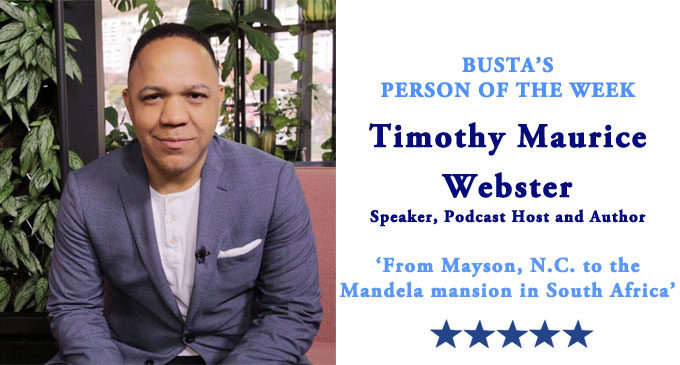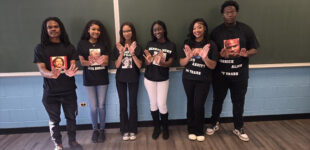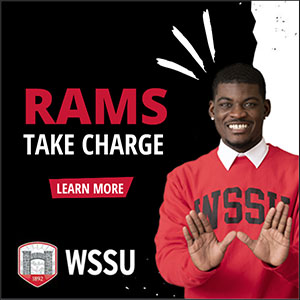Busta’s Person of the Week: From Madison, N.C. to the Mandela mansion in South Africa: Part 2

By Busta Brown
Let’s recap briefly: In Part 1 we learned about Timothy Maurice Webster’s journey from growing up on a farm in Madison, N.C., to becoming a very successful businessman, speaker, author, and podcast host in South Africa, and then marrying into the Mandela royalty.
Tim is a country boy at heart and son of a preacher and a phenomenal mother with a heart of gold. If she stood next to a glass of tea and water, in would turn sweet. His family is very tight and they do most everything together. It speaks volumes on why Tim is an absolute gentleman and a giver. He’s not the tallest guy I know, but he was a big man on the basketball court and extremely popular with the ladies. He always had the most beautiful girlfriends.
Tim grew up in the church, but had an itch to break out of the traditions, “… and I got kicked out of church because of that. I bought a Lauryn Hill CD to my youth ministry class to explore how the hip-hop culture made it from the bottom to the top, and find the commonality between religion and hip-hop. I wanted to relate to our youth in church. They were listening to hip-hop, so I needed to connect their music to what they were learning in church. But they didn’t dig it and I got the boot,” he said without regret.
As a child, he was always fascinated with image, but it was during his time as a shoe salesman at Johnston & Murphy that itch became a scratch. He was and is still the most fashionable man I know. He had style most Black men desired but were afraid to try, until now. Tim was that dude long before this new generation. He’s also a true renaissance man. He cuts hair, designed his own clothes and watches. Branding and fashion are his divine purpose.
So the journey begins. In Part 1 we also learned some fun and interesting facts about one of the greatest world leaders of our time, Nelson Mandela. Tim and Mandela’s granddaughter Celennhle Dlamini met in 1999 at a meeting that she and I had about a fashion show for Bennett College. It began as a strictly platonic friendship between the three of us. Over the next six months, we were joined at the hip. Every weekend we either went to the movies, a concert, dinner, the park, or just chilling at each other’s apartment sharing wild and crazy childhood stories. During the Christmas break in 2000, Celennhle Dlamini went back home to South Africa and weeks later I went to visit my family in San Francisco. She returned a week before I did and reached out to Tim. He said, “She called and said, ‘Yo, where ya’ll at?’ I said I’m here and Manard (my real name) is in Cali. And then we begin hanging and it eventually got serious. She graduated from Bennett and moved to Boston and then I moved to New York. She would come to New York and I would go to Boston, and that’s when it went to the next level.”
When Celennhle would visit her family in South Africa during the holidays, Tim would join her. Before visiting South Africa, he started a branding business while working at the Men’s Warehouse. “I have three phases to my career. When I was a child, I was always fascinated with image. I begin to realize that image was a tool to really help people navigate the world. As a Black man, you know if I wear track pants to a grocery store, security may follow me around. But if I wear a suit to the grocery store, people greet meet like I’m Barack Obama. The second phase of my career was understanding the psychology of image. The third phase of my career I did a two-year program at MIT Sloan School of Management, where I became fascinated with the neuroscience and behavioral science of image, looking at the environment, circumstances and stories that impact people’s brains and how that can ultimately influence how we engage with each other.”
In the early 2000s during Tim’s second visit to South Africa, something spiritual happened. “One day I pick up a newspaper and saw that there was no one in the newspaper writing about image, so I decided to take a leap of faith and move there. When I got back to New York I wrote a letter to the top newspaper in South Africa about can I write a column and they accepted it. So, in my head I figured if I could get on radio stations, in the newspapers, and maybe TV, and use what I’ve learned from you, I might have a chance at this thing,” said Tim.
Of course, I was honored that he credits me in his journey into the media phase of his career. Although we’re friends, I don’t take that lightly. He continued, “I took that leap of faith and moved to South Africa to be with my girl and start my career. After the newspaper gave me the opportunity to write a column on branding, I hustled every single day and night. I hit the streets making connections and somewhat becoming a student in the business world. I listened and learned from as many businessmen and women that gave an ear. I took what I’ve learned from you and what I’ve learned here. Years later, I mastered it all and then started my branding company, wrote five books on branding, became a correspondent on several TV networks in South Africa, traveled the world speaking on branding, and Apple is now showing my podcast as one of the tops in its category. I’m known as ‘the author in the psychology of influence.’”
But it wasn’t smooth sailing the first three years. “Dude! If I had known what I know now, I probably would’ve never moved here. The first three years were hard bro! I didn’t have ID, no driver’s license, and no bank account. I had to count on Celennhle for most everything. I was crushed when I moved here. It’s 1.2 billion people and I only knew one person,” he said while laughing.
Tim shared some fascinating history about his now ex-wife and the traditional order he had to follow to ask for her hand in marriage. “Her uncle is a king, her father is a prince, and her aunt is married to a Zulu king in Swaziland, and it’s the only absolute monarchy left in the world. Her uncle is the sovereign ruler of the country. Because of this, I had to go through three phases to get married. I had to get adopted by a family in Swaziland so they can represent me to her family. They’re what is called my host family. They were the head of a reserve bank in Swaziland and they would negotiate how many cows I would pay to marry Celennhle. Because she was royalty, you had to choose certain type of cows, it couldn’t be just any cow. So, the family had to help me navigate the type of cows to choose. This is called the asking price, so I had to get 10 cows just to ask her to marry me. The idea of this is that if two families can have these cows together, the cows will have babies and they will continue to produce wealth.”
Tim paid for the ten cows, but like all love stories, there was a twist. “We were supposed to go through the Asking Ceremony, an African ceremony, and then the White Wedding Ceremony. But the king couldn’t make the wedding on the day as planned, so instead of doing the White Wedding last, we did that second. My family and friends had already bought their tickets and made hotel reservations, so we had to move forward with the wedding. The negative to that is without the king’s presence, our wedding didn’t really count in her family. But we loved each other, so in 2005 we got married.” Years later, they realized that what they had was more of a friendship than a romance and decided to transition into a beautiful friendship that is still solid today.
In Part 1 Tim shared his intriguing encounter with Jay-Z and Beyonce’. Now let’s talk about his meeting with the phenomenal Oprah. “She changed my life, dude! Outside of America, the only place she did her Live Your Best Life Tour was in Johannesburg, South Africa, because of her relationship with Nelson Mandela. They were very, very close friends. There were ten of us media people sitting in a room and they were giving us a countdown: 30 minutes she will be in the room, so be prepared. One of the girls that was with us was a huge fan. When they said two minutes, the girl started shaking. Oprah walks into the room and says. ‘Hello everyone!’ This girl walks up to Oprah, touches her on the shoulder and then fainted. So she didn’t get to meet her,” he said as he’s cracking up laughing. By the way, the young lady was fine. Just excited, as I was when I met Stevie Wonder. I trembled as well.
Tim continues with his fascinating encounter with the queen of media. “I went up to Oprah and said, ‘You don’t know it yet, but you’re to write a foreword in my book.’ Then she looked at me and said, ‘You don’t know it, but I don’t write forewords,” and again we busted out with laughter. It was tough interviewing my best friend because we have the same wild and crazy sense of humor. So I imagined the expression on his face when Oprah walked away. Tim said his heart dropped and turned cold. But he said she’s as beautiful inside as she is outside. Oprah decided to give Tim a chance. “She was phenomenal, bro! She turned around and comes back and asked, ‘What’s your name again?’ And then asked about my book. That particular book was called ‘Personovation.’ I told her it was about what do you do when you outgrow what you’re known for. At this stage I was interested in how we evolve past what we’re known for. I came up with the concept because one day I thought about that fact I’m no longer known as just Busta’s friend in North Carolina, or the guy that’s married to Mandela’s granddaughter. So, I thought about how do I reposition that? And I shared that with Oprah. She suggested that I contact Naomi Campbell, because she’s moving in that direction.”
Tim replies slowly, sarcastically and humorously. “Oprah, I can’t just pick up the phone and call Naomi Campbell, I don’t have her number. And dude! I had Oprah laughing out loud. I made Oprah laugh! We’re having a fun conversation and then the camera person asked if I could hurry it up because we need to get her back on onstage. But she was enjoying our conversation, so when you look at the photo of us, she’s pinching me on the side. She was so cool, bro. I became an even bigger fan of Oprah the person. Before she left, she gave me a few tips: Don’t settle, go to the top, because these are the people that need this conversation. After you take it to the top, then go back and take it to the bottom. And that hit me hard! She also shared why she doesn’t write forewords. At this time Dr. Maya Angelou was living. She said, ‘Maya asked me to write a foreword to her book, but I didn’t because if people don’t like me, they won’t buy it. If they like me, they’ll buy without the actual merit of the book. So, I don’t want to sway somebody’s book.’” Wow! Not many people get to tell this story. Way to go Tim!
The fascinating encounters kept coming. He shared the hilarious story behind the photo he took with former U.S. President Bill Clinton and Bishop Desmond Tutu. “They were at this annual lecture where they challenge Mandela’s legacy. Clinton and Mandela are very close as well. Mandela was phenomenal at raising funds. When he got out of prison, he called Clinton and said, ‘I need the U.S. government to give me two hundred million dollars to start entrepreneurship development and make it happen.’ And Clinton made it happen! They were that close. That became the Southern African Enterprise Development Fund.” Tim’s good friend is now the director of the organization.
He said while at the lecture, he accidently opened a door and there stood President Clinton and Bishop Tutu. “I threw up my arms like, oh snap, I’m in the wrong room, and then they threw up their arms like, hey, and came and gave me a hug. And right at that moment a photographer came into the room and asked if we wanted a photo and they said yes. And had these big smiles as if we all knew each other. Soon as the photographer took the picture, I’m like I got to get the hell out of here. I introduced myself and thanked them and I left. So that’s the story,” he ends with a huge smile on his face.
He also interviewed Steve and Marjorie Harvey during their visit to South Africa. “They were a delight to meet, very down to earth.”
He closed our interview with his thoughts on the COVID-19 pandemic and police brutality. “This will be quick. The reason America isn’t doing well is because they’re not taking it seriously. That’s it. You won’t see one person in most countries without a mask. Take it seriously, cuz there’s no COVID problem here,” he said with pride. “As for police brutality, the system in America is designed to reduce and weaken the Blacks, but you won’t find that anywhere else in the world. So, there is no global support around the issue of police brutality. The world is supporting the end of racism. The world is supporting the global attempt to destroy westernized white supremacy. Anywhere there’s brown people, we want to destroy any system of white supremacy. Man, you gotta get here soon, you’ll love it here. Love you, bro.”
My Person of the Week is Timothy Maurice Webster. To contact Tim, visit www.timothymaurice.com or on IG and Facebook @Timothy Maurice Webster, or the Brand Show podcast with Timothy Maurice Webster.















